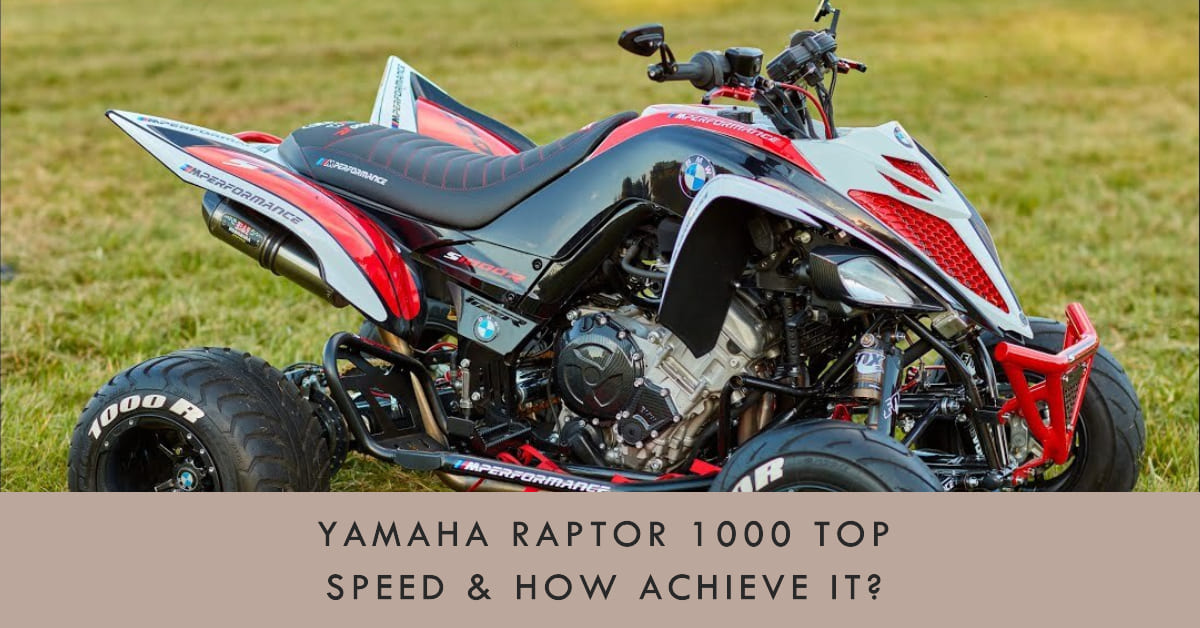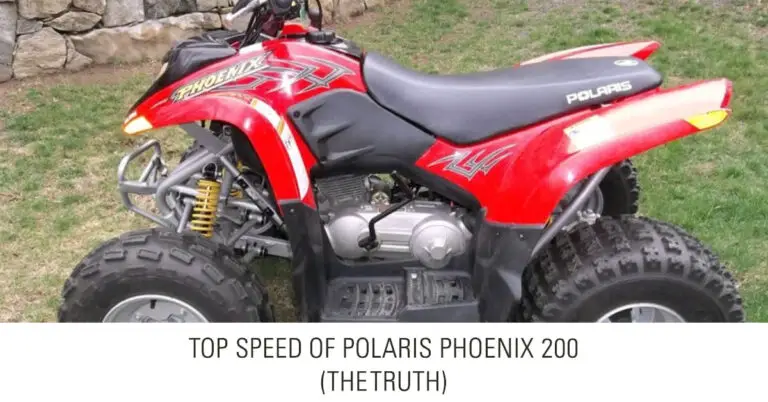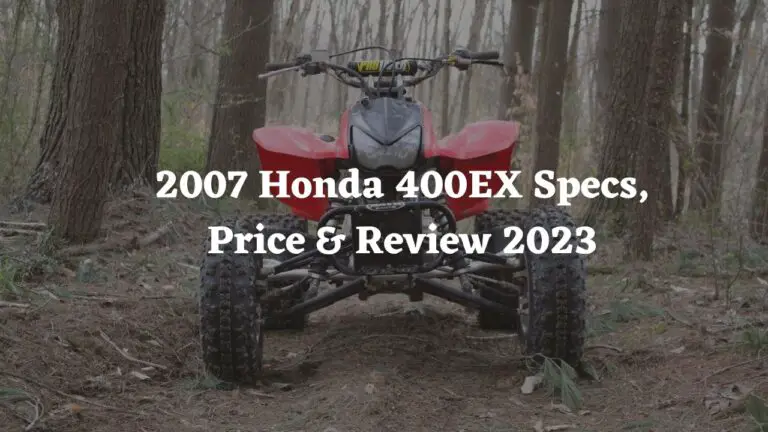Yamaha Raptor 1000 Top Speed & How Achieve It?

If you own or are considering purchasing the high-performance Yamaha Raptor 1000 ATV, you may be wondering just how fast this powerful sport quad is capable of going. The Raptor 1000 has a large 998cc engine and advanced components that allow it to reach blistering speeds in excess of 80 mph out of the box.
With some key aftermarket modifications, riders have recorded verified top speeds over 100 mph on the Raptor 1000. However, extreme speeds also come with risks that require caution and the right safety gear to manage.
In this in-depth article, we’ll cover everything you need to know about achieving top speed on the Yamaha Raptor 1000:
- What is the stock top speed and acceleration?
- How engine and transmission specs influence speed.
- The fastest recorded speeds with mods.
- The best performance upgrades to increase top speed.
- Safety tips for attempting high speed runs.
- Owner impressions on the Raptor 1000’s speed and handling.
Plus, we’ll provide key specs, a comparison chart, pricing info, known issues, and the best Raptor 1000 alternatives on the market. Let’s get started!
Table of Contents
What is the stock top speed and acceleration?
So what is the top speed of the Raptor 1000 right off the showroom floor? Here are the stock speed specs:
- Stock top speed: 80-85 mph
- 0-60 mph acceleration: Under 4.5 seconds
Yamaha does not officially publish the top speed of their ATVs, but independent testing and owner reports consistently show stock top speeds of 80-85 mph on the Raptor 1000.
This makes it one of the fastest stock ATVs available from any major manufacturer. The Raptor 1000’s great power-to-weight ratio, strong acceleration, and 5-speed transmission tuned for high speed provide the impressive velocity.
Yamaha Raptor 1000 Engine And Transmission For Speed
Let’s look under the hood at the components that enable the Yamaha Raptor 1000 to reach exhilarating speeds:
- 998cc liquid-cooled engine: The big 999cc 4-stroke engine generates around 90 HP, providing tremendous power for a stock ATV. The liquid cooling and dry sump lubrication enable the motor to withstand high RPMs without overheating.
- Dual overhead cams: DOHC valve train means better breathing and higher rpm capability than a single overhead cam engine.
- 5-speed transmission: Low gearing in 1st gear helps acceleration. Tall 5th gear enables higher top speeds than a 4-speed transmission.
- Manual clutch: Gives the rider full control of gear changes and power delivery for fast take offs.
- Front and rear disc brakes: Provide strong stopping power when braking from high speeds. Steel braided lines offer better braking feel.
The engine performance combined with optimized gear ratios for acceleration and top speed give the Raptor 1000 incredible speed potential right off the showroom floor.
What is the Fastest Recorded Top Speed for a Yamaha Raptor 1000?
While 80-85 mph is fast for a stock ATV, some modified Raptor 1000 owners have reached even higher verified top speeds. Here are some fast figures:
- 102 mph – The fastest recorded time is 102 mph set by RaptorForum member tDub. Mods included a full Yoshimura exhaust, HMF optimizer, UNI air filter, and Dalton clutch kit.
- 100+ mph – There are multiple reports of exceeding 100 mph with similar intake, exhaust, and clutch tuning mods to enhance power.
- 90+ mph – Many owners with just basic bolt-on exhaust and air intake mods have reached over 90 mph.
When attempting these speeds, it takes a skilled rider under controlled conditions. But the capabilities of the Yamaha Raptor engine and chassis allow for triple digit top speeds. Just be sure to take proper safety precautions outlined below.
How to Increase Yamaha Raptor 1000 Top Speed?
While the Raptor 1000 is darn quick in stock form, you can coax even higher top speed out of it with targeted upgrades. Here are the best mods to help increase top speed:
- Exhaust – An aftermarket exhaust like Yoshimura, Two Brothers, or HMF can add several HP which translates to higher speed. Avoid loud exhausts for recreational riding areas that have sound limits.
- Intake – A less restrictive air filter kit with high flow intake tube optimizes airflow. K&N and UNI filters are popular upgrades. Rejet carb for intake mods.
- Clutch kits – A clutch kit with stiffer springs allows the clutch to hold more power at high RPM without slipping. Dalton, EPI, and Hinson kits are top options.
- Fuel controller – Adds more fuel to match the added airflow from intake and exhaust mods. VDI and Dynojet Power Vision are good fuel tuners.
- Gearing change – Installing lower ratio sprockets increases acceleration and top speed potential in higher gears.
With the right combination of these performance mods, hitting that 100+ mph milestone is within reach for many riders. Let’s move on to talking about staying safe at speed.
Yamaha Raptor 1000 Top Speed Safety Tips
Pushing any ATV to its limits comes with risks. Here are important safety tips to follow if you plan on testing the top speed of your Yamaha Raptor 1000:
- Wear safety gear – Always wear an approved helmet, goggles, gloves, over the ankle boots, protective jacket and pants. Safety gear could save your life in a high speed crash.
- Avoid public trails – Only attempt top speed runs in controlled environments like a dirt track or large private field far from obstructions and people. Never try to max speed on public trails.
- Start slow – Even if you’re an experienced rider, take time to get very familiar with the handling at moderate speeds before running it flat out. Build up slowly.
- Inspect ATV – Check tire pressure and tread wear. Ensure brakes are in top condition. Look for fluid leaks. Make sure all maintenance is up to date before speed runs.
- Pick terrain carefully – Scan the terrain ahead to avoid holes, ruts, rocks, and bumps that could cause control issues at speed. Know the land you’ll be riding on.
- Caution in turns – Understand drift and weight transfer. Excess speed in turns can lead to rollovers or flying off the track. Avoid abrupt steering inputs at speed.
- Stay alert – Focus 100% of your attention on controlling your Raptor when traveling at high velocity off-road. Avoid distraction and fatigue.
The Yamaha Raptor 1000 has great stability and handling for an ATV. But physics takes over at extreme speeds, so smart preparation and riding style adjustments are required to stay safe.
Yamaha Raptor 1000 Specs Chart
| Specification | Measurement |
|---|---|
| Engine | 998cc liquid-cooled 4-stroke |
| Valvetrain | DOHC 5-valve |
| Transmission | 5-speed manual /w reverse |
| Wheelbase | 50.8 in. |
| Seat height | 31.9 in. |
| Ground clearance | 4.3 in. |
| Fuel capacity | 5.3 gallons |
| Front suspension travel | 9.1 in. |
| Rear suspension travel | 10.1 in. |
| Dry weight | 432 lb |
Yamaha Raptor 1000 Pros and Cons
Pros
- Powerful 998cc sport ATV engine
- Blistering acceleration and 80+ mph top speed
- Excellent handling for a high speed quad
- Quality Yamaha fit and finish
- 5-speed transmission tuned for speed
Cons
- No ABS option unlike newer models
- Can feel heavy in tight, technical riding
- Expensive when new
- Thirsty 5.3 gallon tank needs frequent fill ups
- High speeds increase crash risks
Yamaha Raptor 1000 Top Speed by Model Year
The Yamaha Raptor 1000 was sold from 2001 to 2005 in the US. The speed and performance specs remained consistent across the production run with no major mechanical changes. Only colorways and graphics were updated annually.
| Model Year | Top Speed | Horsepower |
|---|---|---|
| 2001 | 80-85 mph | 90 hp |
| 2002 | 80-85 mph | 90 hp |
| 2003 | 80-85 mph | 90 hp |
| 2004 | 80-85 mph | 90 hp |
| 2005 | 80-85 mph | 90 hp |
Yamaha Raptor 1000 Original MSRP and Used Pricing
The Raptor 1000 carried premium pricing when new due to its powerful engine and high end components. Here were the original MSRP prices by year:
| Model Year | MSRP Price |
|---|---|
| 2001 | $8,199 |
| 2002 | $8,299 |
| 2003 | $8,399 |
| 2004 | $8,499 |
| 2005 | $8,599 |
Today, excellent condition used Yamaha Raptor 1000 models tend to sell for $4,000 to $6,500. Lower mileage, unmodifed examples can fetch over $7,000. Poorly maintained or heavily abused quads sell for under $3,000.
What Owners Are Saying About the Yamaha Raptor 1000 Top Speed
The combination of light weight, a responsive engine, and capabilities at high speed make the Yamaha Raptor 1000 a favorite among owners. Here’s what they say about its speed and handling:
Positive Owners Feedback
“This thing rips! I hit 93 mph indicated on a flat dirt road. It pulls hard through all gears.”
“The stability of the Raptor chassis at 80+ mph is really impressive. High speed whoops and turns feel planted.”
“Love the 5 speed transmission. First gear is great for low speed crawling. Fifth lets it reach the crazy top speeds.”
Constructive Owner Criticism
“Stock suspension is underdamped for high speed hits and landings. I upgraded to better shocks.”
“The lack of ABS is scary when braking hard from max speed. You better know what you’re doing.”
“It feels noticeably heavy in technical riding vs the lighter 700-800cc sport quads. Taking turns slow is harder.”
Overall most owners agree the 1000cc engine delivers thrilling speed coupled with good stability and control for experienced riders. Minor downsides exist like suspension limits and bulk in tight terrain.
Major Yamaha Raptor 1000 Problems and Fixes
While a well maintained Raptor 1000 can be reliable, there are a few common issues to look out for, especially on high-mileage or abused examples:
- Blown head gaskets – Running hot and over-revving can cause head gasket failure. Replacement gaskets, new bolts, and checking head straightness fixes this issue.
- Worn suspension – Hard riding takes a toll on the stock shocks. Quality aftermarket shocks from Elka, Fox Racing, and others transform handling.
- Clutch problems – Heavier clutch springs, new fiber plates, and clutch cover gasket replacement often resolves clutch slip, chatter, and drag issues.
- Electrical – Faulty CDI boxes, voltage regulators, and stators are not uncommon. Replace bad electrical components with OEM or acceptable aftermarket parts.
- CarbJet wear – Cleaning or rebuilding the carburettor and replacing worn jets maintains perfect fueling.
Following the maintenance schedule and avoiding abuse limits problems. For issues that do arise, owners have identified proven solutions to keep this classic sport ATV running in top form.
Best Yamaha Raptor 1000 Alternatives
The Raptor 1000 reigned supreme when introduced in 2001. Today there are more options in the big bore sport ATV segment. Here are a few top Yamaha Raptor 1000 alternatives to also consider from a speed and performance standpoint:
- Yamaha YFZ450R – The updated YFZ450R packs a powerful 449cc fuel injected engine with 5-speed and reverse. Less power than the 1000cc Raptor but much lighter and nimbler.
- Suzuki QuadRacer LT-R450 – Nearly 10hp more than the 450 class rivals. Race-ready performance with a 5-speed manual transmission. Does 85+ mph out of the box.
- Honda TRX450R – Legendary and proven 450cc powerplant. The 2022 TRX450R gets fuel injection, new chassis, and 6-speed transmission for increased speed.
- Can-Am DS 450 Pro X mx – Rotax 449cc engine packs 60 HP stock. Excellent power-to-weight. Designed for cross-country racing right off the showroom floor.
Any of these high-performance 450 class sport quads give the vintage Raptor 1000 a run for its money when it comes to speed and handling. Test ride them back to back when deciding!
Conclusion
We hope this deep dive gives you all the information on unlocking the Yamaha Raptor 1000’s top speed potential while staying safe and in control. What’s your Raptor 1000’s top speed? Let us know in the comments! Ride on!







